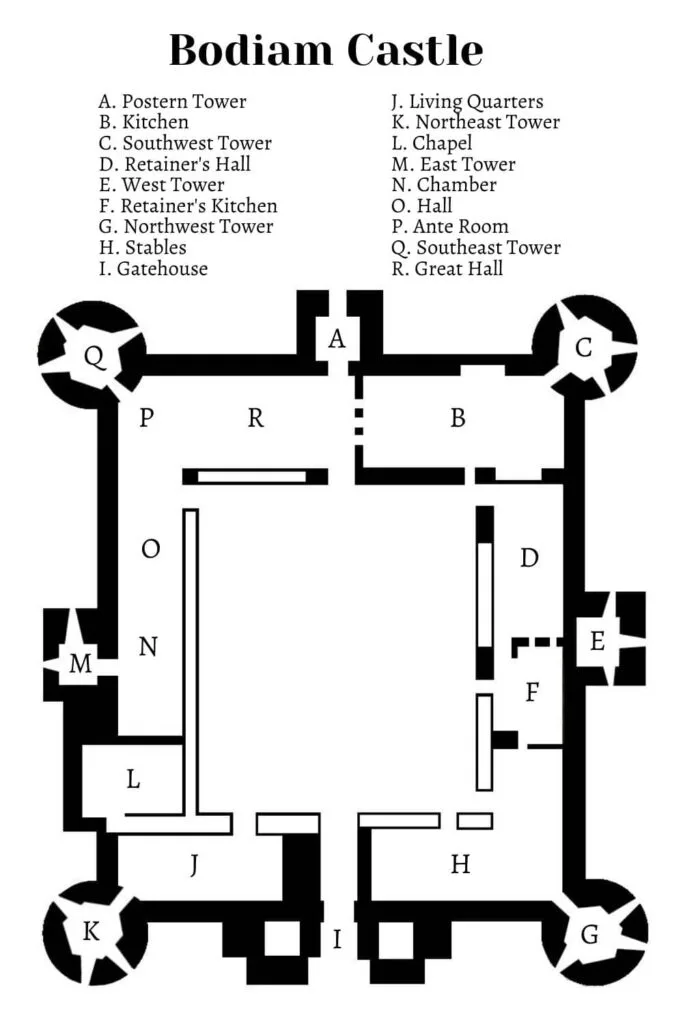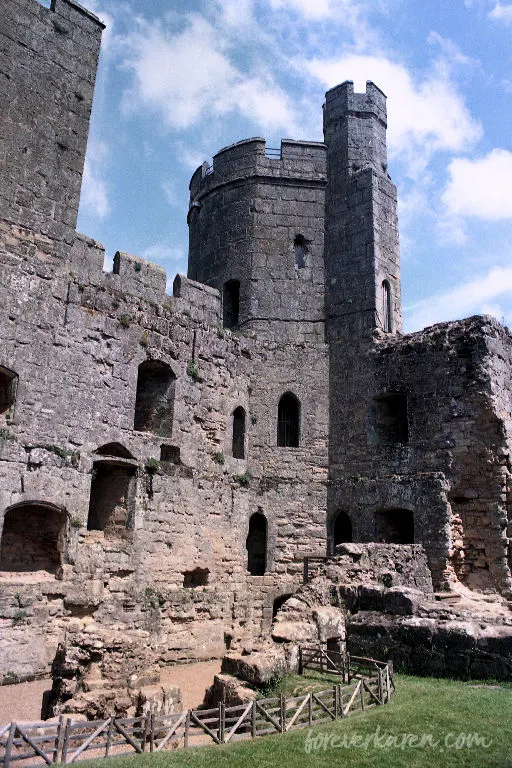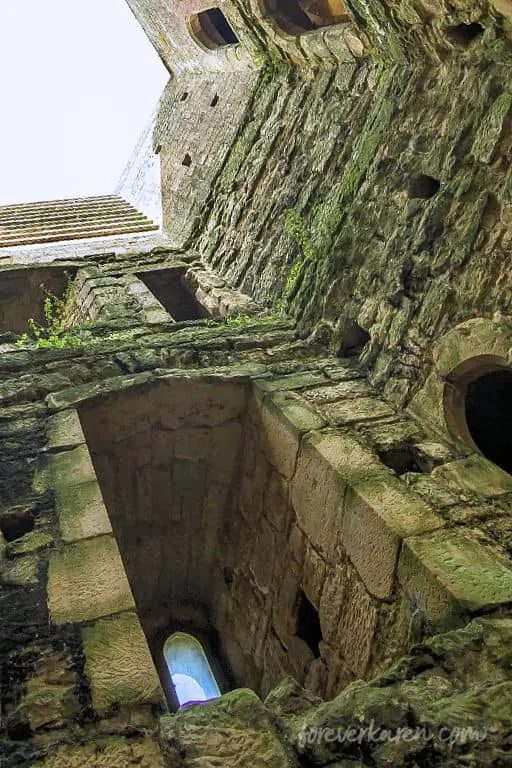
When looking for a day out in Sussex, England, it’s hard to choose between the plethora of medieval castles, historical attractions, and off-the-beaten-track gems. While most tourists prefer the magnificent Arundel Castle, consider exploring a castle ruin instead.
Bodiam Castle, known for its fairy-tale persona, is the quintessential castle with a moat and surrounding vineyards. Built in the 14th century, the picturesque ruin swept me away, into a romantic storybook.
Constructed near the River Rother, I could imagine that during its construction, it was the epitome of medieval splendor. Bodiam is built in the shape of a square, its reflection in the wide moat makes it appear more prominent, which would have discouraged the enemy.
The History Of Bodiam Castle

Bodiam Castle is located in Robertsbridge, East Sussex, 11 miles north of Hastings, an English seaside town worth visiting.
Sir Edward Dalyngrigge constructed Bodiam’s fairy-tale castle in 1385. Sir Edward Dalyngrigge has served in the hundred years war, and upon his return, married Elizabeth Wardeux.
With Richard II’s permission, he turned Bodiam Manor into the moated castle seen today. It’s believed its purpose was to defend the area against a French invasion.
The medieval castle’s design is simple compared to other English strongholds. Its square foundation features no keep, but drum towers anchor each corner as it overlooks a man-made lake.
Although built for defense, it didn’t see any real action until a century later. In 1484, King Richard III captured the East Sussex castle from Sir Thomas Lewknor. Its thin walls and large windows proved no match against the enemy.
The castle was besieged again in 1643, and the occupants quickly surrendered to Sir William Waller. Afterward, parts of the castle were dismantled and the structure was left in ruins. The following year, the estate was sold for GBP 6,000.
Throughout its history, the castle saw many owners, including John Tufton and John Fuller, who sold it to George Cubitt, the Baron Ashcombe. Its last owner, Lord Curzon, donated the estate to the National Trust upon his death in 1926.
Today, the National Trust allows visitors to stroll its castle grounds, cross its quaint bridge, and climb a tower or two.
Getting To Bodiam Castle
Bodiam Castle is located in southeast England, on the border of East Sussex and Kent. With limited public transport in the area, it’s best reached by car off the B2244 or A268 east of Robertsbridge. The castle has a paid car park which costs GPB 4.00 per vehicle.
Alternatively, for a bit of nostalgia, plan to ride the Tenterden Steam Railway from Tenterden to Bodiam Station. The steam train adds a beautiful way to enjoy the Sussex countryside before your Bodiam Castle tour.

Castle opening hours are 10 am to 4:30 pm, and the car park opens fifteen minutes before the castle. Admission costs GBP 11.00 for adults, GBP 5.50 for children, and family passes are GBP 27.50. National Trust members have free access to the castle and parking too.
Wheelchair accessibility is limited. The grounds inside the curtain walls are gravel and grass, with some slopes. The towers are not wheelchair accessible.
The estate welcomes dogs on short leads. However, the castle only allows only assistance dogs inside the castle walls.
On a sunny day, pack a picnic and enjoy your lunch on the grounds while admiring the medieval ruins. Alternatively, the Wharf tea-room and Castle View Café offer freshly cooked scones, sandwiches, and tempting treats.
During the warmer months, some visitors boat or canoe on River Rother to access the 14th-century moated castle.
Visitors should plan their trip carefully as the estate has no shelter from wet weather. So, choose to visit on a dry day or carry a compact umbrella just in case.
The Castle Exterior
Approaching the castle, it’s hard not to fall in love with this Sussex attraction. In fact, it’s one of the most photographed castles in England.
Standing in awe of its beauty, I noted its moated design is reminiscent of Leeds Castle, the “loveliest castle in the world.” Bodiam Castle’s embattled towers dominate the skyline, and the surrounding moat appears too picture-perfect.
While the structure looks imposing, it’s relatively small on the inside. The curtain walls measure two meters or seven feet thick at its base, relatively thin for a defensive stronghold. In comparison, nearby Pevensey Castle’s curtain walls are 4.2 meters thick at the base.

Unlike most castles that were constructed over time, Bodiam was built in one phase. Made from Wealden sandstone, its design leans towards one architectural period, and its style hasn’t wavered over the years.
Initially, the castle had two entrances, with the main entry through the Barbican. As you enter the main gate, look above at the three medieval coats of arms.
One represents Sir Edward’s family, another his wife’s, and the Radynden coat of arms was related to the Dalyngrigges. Above, a helmet with a unicorn represents the helmet he wore in battle.
On the opposite side and nearer the parking lot, a bridge once led to the Postern Gate and behind it, the great hall to the right and the kitchen on the left. The footbridge was narrow and not suitable for horses or carts.
Inside Bodiam Castle
Upon arrival, a short film documents the castle’s history from its construction to the present day. In contrast to its almost complete curtain wall, its castle courtyard lay in complete ruins. Much of the inner destruction was the result of a parliament dismantling after the English Civil War.
Today, visitors cross the moat on a newer bridge, but the foundations of the initial bridge are still visible. While the Barbican is gone, I could admire the oak portcullis, a heavy vertical gate at the Gatehouse.

Although not much remains inside the walls, it doesn’t detract from its grand presence and romantic appearance. While no one resides inside the castle walls, the Gatehouse has become home to a cauldron of bats. In fact, five species of bats live there.
Bodiam Castle’s layout is easy to imagine, even without its complete inner walls. Since much of the interior has gone, most visitors spend their time climbing the spiral staircases to the top of the battlements. Slotted windows riddle these 13-meter (43 foot) towers, used to defend the castle.
It’s important to note that the staircases are steep and narrow, and space on the tower’s top is limited. So, exercise patience before your turn. From the tower, I admired the views of the castle’s courtyards and beautiful Sussex countryside in every direction.

Next to the kitchen, the southwest tower houses a deep pool. Probably filled by a spring, the water was most likely the occupants drinking water or used for cooking given its proximity to the kitchen.
At ground level, the foundations of the walls remain so visitors can see the location of the kitchen, anteroom, stables, and chapel. Above the entrance, murder holes provided a way to attack the enemy with boiling tar.
Fortress Or Palace?
Recently, historians have debated the initial purpose of Bodiam Castle. Was it built as a fortress or a beautiful, noble home to entertain? While the speed at which it was made might suggest Dalyngrigge needed it for defense, there is another theory.
The British constructed most military strongholds on a hill for the best sight of the surrounding land. However, Sir Edward selected Bodiam’s location because the ground was low-lying and easy to flood, creating a moat.
Even though a moat surrounds the castle, it’s only eight feet deep, which meant the enemy could quickly drain it. The curtain walls measure two meters thick at its base, considered relatively thin for a military base.
Its walls are made of sandstone, considered quite a soft material for a castle. Also, the exterior walls contain large windows rather than thin, slotted ones seen in other British strongholds.
While rebels attacked Bodiam Castle twice throughout history, the castle surrendered both times. Since it was never successful as a defensive stronghold, its purpose for construction may have been for prestige and entertainment.

Whatever the reason, the National Trust continues to maintain and restore this British treasure for all to enjoy.
Things To Do Near Bodiam Castle
Since it only takes an hour to explore the castle ruins of Bodiam, consider combining your visit with some other Sussex attractions. Here are some places of interest nearby.
Battle Abbey – Walk the grounds of one of Britain’s most famous battles, the Battle of Hastings in 1066. Nearby, visitors can explore the ruins of Battle Abbey, a memorial to those who lost their lives on the battlefield.
Bateman’s – A beautiful 17th-century Sussex estate that was once the home of Rudyard Kipling. Explore its gardens to see what influenced his writings.
Sissinghurst Castle Garden – Sissinghurst Castle has a varied past and once served as a prison. Today, its gardens have been magnificently transformed into a horticultural paradise of international plants. The National Trust also owns this estate.
Brede Steam Giants – Located in the lovely Brede Valley, the facility displays a collection of bygone water pumping engines. While the original machines used steam, the exhibit documents the history of such engines to the modern day.
Smugglers Adventure – Located in Hastings on the coast, the center documents the history of smuggling. The hills conceal old smugglers’ caves holding dark secrets of bootlegging and hardships of smuggling.
Hastings Castle – built by William the Conqueror, it’s mostly in ruins but provides some spectacular views of the Sussex countryside.
If you’re traveling with children, consider a child-friendly stay in a converted railway carriage, in nearby Northiam.
Finals Thoughts
While there are many English castles, visitors wanting to see a castle should not miss Bodiam’s ruins. Throughout the year, it holds special events that feature birds of prey, falconry, and people dressed in period costumes demonstrating medieval skills.
Its inexpensive admission fee makes for a lovely family outing and a great way to support the continuing restoration of this beautiful Sussex castle.
Happy travels ~ Karen
